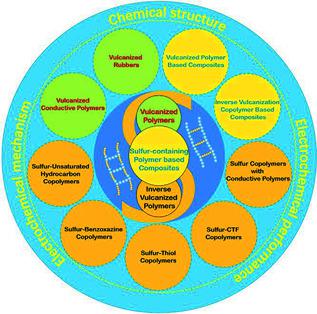当前位置:
X-MOL 学术
›
Small Methods
›
论文详情
Our official English website, www.x-mol.net, welcomes your
feedback! (Note: you will need to create a separate account there.)
Recent Advances in Applying Vulcanization/Inverse Vulcanization Methods to Achieve High‐Performance Sulfur‐Containing Polymer Cathode Materials for Li–S Batteries
Small Methods ( IF 10.7 ) Pub Date : 2018-08-19 , DOI: 10.1002/smtd.201800156 Fulai Zhao 1, 2 , Yu Li 1, 2 , Wei Feng 1, 2, 3, 4
Small Methods ( IF 10.7 ) Pub Date : 2018-08-19 , DOI: 10.1002/smtd.201800156 Fulai Zhao 1, 2 , Yu Li 1, 2 , Wei Feng 1, 2, 3, 4
Affiliation

|
Lithium–sulfur (Li–S) batteries have great prospects as next‐generation energy storage devices because of their high energy density, inexpensive raw materials, and low pollution. However, the development of Li–S batteries is currently restricted by the shuttle effect that occurs during the charge–discharge process. Sulfur‐containing polymers are attractive for use as Li–S battery cathode materials to alleviate the shuttle effect through chemical bonds as well as physical confinement. Moreover, polymers have numerous different molecular structures and definable functional groups. A suitable monomer design can result in a final sulfur‐containing polymer possessing favorable properties such as ion and electron conductivity, high sulfur content, appropriate viscosity, processability, and controllable morphology. These characteristics are of great benefit for use in Li–S battery cathodes to achieve high capacity and stable discharge at high rates. This review summarizes recent developments in sulfur‐containing polymer cathode materials. Focusing on polymers prepared by the facile and low‐cost vulcanization/inverse vulcanization methods and the polymer‐based composites, the chemical structures and electrochemical mechanisms are clarified, and the relationship between their structures and performances is discussed comprehensively. It is expected that more polymer electrode materials with high performance will emerge in the coming years.
中文翻译:

应用硫化/逆硫化方法获得用于Li-S电池的高性能含硫聚合物阴极材料的最新进展
锂硫(Li–S)电池具有高能量密度,廉价的原材料和低污染的优点,因此有望成为下一代储能设备。但是,Li-S电池的发展目前受到充放电过程中出现的穿梭效应的限制。含硫聚合物作为Li-S电池正极材料很有吸引力,可以通过化学键和物理限制来减轻穿梭效应。此外,聚合物具有许多不同的分子结构和可定义的官能团。适当的单体设计可以使最终的含硫聚合物具有良好的性能,例如离子和电子电导率,高硫含量,适当的粘度,可加工性和可控的形态。这些特性对于在Li–S电池阴极中使用以实现高容量和高速率稳定放电非常有益。这篇综述总结了含硫聚合物阴极材料的最新发展。重点介绍了通过简便,低成本的硫化/逆硫化方法制备的聚合物以及基于聚合物的复合材料,阐明了其化学结构和电化学机理,并全面讨论了其结构与性能之间的关系。预计在未来几年中将出现更多高性能的聚合物电极材料。重点介绍了通过简便,低成本的硫化/逆硫化方法制备的聚合物以及基于聚合物的复合材料,阐明了其化学结构和电化学机理,并全面讨论了其结构与性能之间的关系。预计在未来几年中将出现更多具有高性能的聚合物电极材料。重点介绍了通过简便,低成本的硫化/逆硫化方法制备的聚合物以及基于聚合物的复合材料,阐明了其化学结构和电化学机理,并全面讨论了其结构与性能之间的关系。预计在未来几年中将出现更多具有高性能的聚合物电极材料。
更新日期:2018-08-19
中文翻译:

应用硫化/逆硫化方法获得用于Li-S电池的高性能含硫聚合物阴极材料的最新进展
锂硫(Li–S)电池具有高能量密度,廉价的原材料和低污染的优点,因此有望成为下一代储能设备。但是,Li-S电池的发展目前受到充放电过程中出现的穿梭效应的限制。含硫聚合物作为Li-S电池正极材料很有吸引力,可以通过化学键和物理限制来减轻穿梭效应。此外,聚合物具有许多不同的分子结构和可定义的官能团。适当的单体设计可以使最终的含硫聚合物具有良好的性能,例如离子和电子电导率,高硫含量,适当的粘度,可加工性和可控的形态。这些特性对于在Li–S电池阴极中使用以实现高容量和高速率稳定放电非常有益。这篇综述总结了含硫聚合物阴极材料的最新发展。重点介绍了通过简便,低成本的硫化/逆硫化方法制备的聚合物以及基于聚合物的复合材料,阐明了其化学结构和电化学机理,并全面讨论了其结构与性能之间的关系。预计在未来几年中将出现更多高性能的聚合物电极材料。重点介绍了通过简便,低成本的硫化/逆硫化方法制备的聚合物以及基于聚合物的复合材料,阐明了其化学结构和电化学机理,并全面讨论了其结构与性能之间的关系。预计在未来几年中将出现更多具有高性能的聚合物电极材料。重点介绍了通过简便,低成本的硫化/逆硫化方法制备的聚合物以及基于聚合物的复合材料,阐明了其化学结构和电化学机理,并全面讨论了其结构与性能之间的关系。预计在未来几年中将出现更多具有高性能的聚合物电极材料。










































 京公网安备 11010802027423号
京公网安备 11010802027423号